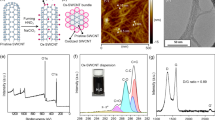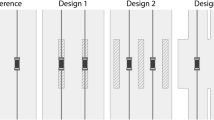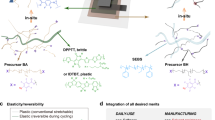Abstract
Conductive electrodes and electric circuits that can remain active and electrically stable under large mechanical deformations are highly desirable for applications such as flexible displays1,2,3, field-effect transistors4,5, energy-related devices6,7, smart clothing8 and actuators9,10,11. However, high conductivity and stretchability seem to be mutually exclusive parameters. The most promising solution to this problem has been to use one-dimensional nanostructures such as carbon nanotubes and metal nanowires coated on a stretchable fabric12,13, metal stripes with a wavy geometry14,15, composite elastomers embedding conductive fillers16,17 and interpenetrating networks of a liquid metal and rubber18. At present, the conductivity values at large strains remain too low to satisfy requirements for practical applications. Moreover, the ability to make arbitrary patterns over large areas is also desirable. Here, we introduce a conductive composite mat of silver nanoparticles and rubber fibres that allows the formation of highly stretchable circuits through a fabrication process that is compatible with any substrate and scalable for large-area applications. A silver nanoparticle precursor is absorbed in electrospun poly (styrene-block-butadiene-block-styrene) (SBS) rubber fibres and then converted into silver nanoparticles directly in the fibre mat. Percolation of the silver nanoparticles inside the fibres leads to a high bulk conductivity, which is preserved at large deformations (σ ≈ 2,200 S cm–1 at 100% strain for a 150-µm-thick mat). We design electric circuits directly on the electrospun fibre mat by nozzle printing, inkjet printing and spray printing of the precursor solution and fabricate a highly stretchable antenna, a strain sensor and a highly stretchable light-emitting diode as examples of applications.
This is a preview of subscription content, access via your institution
Access options
Subscribe to this journal
Receive 12 print issues and online access
$259.00 per year
only $21.58 per issue
Buy this article
- Purchase on Springer Link
- Instant access to full article PDF
Prices may be subject to local taxes which are calculated during checkout





Similar content being viewed by others
References
Park, S-I. et al. Printed assemblies of inorganic light-emitting diodes for deformable and semitransparent displays. Science 325, 977–981 (2009).
Yu, Z., Niu, X., Liu, Z. & Pei, Q. Intrinsically stretchable polymer light-emitting devices using carbon nanotube–polymer composite electrodes. Adv. Mater. 23, 3989–3994 (2011).
Sekitani, T. et al. Stretchable active-matrix organic light-emitting diode display using printable elastic conductors. Nature Mater. 8, 494–499 (2009).
Khang, D-Y., Jiang, H., Huang, Y. & Rogers, J. A. A stretchable form of single-crystal silicon for high-performance electronics on rubber substrates. Science 311, 208–212 (2006).
Shin, G. et al. Stretchable field-effect transistor array of suspended SnO2 nanowires. Small 7, 1181–1185 (2011).
Lipomi, D. J., Tee, B. C-K., Vosgueritchian, M. & Bao, Z. Stretchable organic solar cell. Adv. Mater. 23, 1771–1775 (2011).
Hu, L. et al. Stretchable, porous and conductive energy textiles. Nano Lett. 10, 708–714 (2010).
Service, R. F. Electronic textiles charge ahead. Science 301, 909–911 (2003).
Lipomi, D. J. et al. Skin-like pressure and strain sensors based on transparent elastic films of carbon nanotubes. Nature Nanotech. 6, 788–792 (2011).
Yamada, T. et al. A stretchable carbon nanotube strain sensor for human-motion detection. Nature Nanotech. 6, 296–301 (2011).
Chen, Z. et al. Three-dimensional flexible and conductive interconnected graphene networks grown by chemical vapour deposition. Nature Mater. 10, 424–428 (2011).
Shim, B. S., Chen, W., Doty, C., Xu, C. & Kotov. N. A. Smart electronic yarns and wearable fabrics for human biomonitoring made by carbon nanotube coating with polyelectrolytes. Nano Lett. 8, 4141–4157 (2008).
Madaria, A. R., Kumar, A. & Zhou, C. Large scale, highly conductive and patterned transparent films of silver nanowires on arbitrary substrates and their application in touch screens. Nanotechnology 22, 245201 (2011).
Bowden, N., Brittain, S., Evans, A. G., Hutchinson, J. W. & Whitesides, G. M. Spontaneous formation of ordered structures in thin films of metals supported on an elastomeric polymer. Nature 393, 146–149 (1998).
Ahn, B. Y. et al. Omnidirectional printing of flexible, stretchable, and spanning silver microelectrodes. Science 323, 1590–1593 (2009).
Chun, K-Y. et al. Highly conductive, printable and stretchable composite films of carbon nanotubes and silver. Nature Nanotech. 5, 853–857 (2010).
Sekitani. T. et al. A rubber like stretchable active matrix using elastic conductors. Science 321, 1468–1472 (2008).
Park, J. et al. Three-dimensional nanonetworks for giant stretchability in dielectrics and conductors. Nature Commun. 3, 916 (2012).
Pasch, H. & Schrepp, W. in MALDI-TOF Mass Spectrometry of Synthetic Polymers Ch. 3, 72–73 (Springer, 2003).
Macha, S. F., Limbach, P. A., Hanton, S. D. & Owens, K. G. Silver cluster interferences in matrix-assisted laser desorption/ionization (MALDI) mass spectrometry of nonpolar polymers. J. Am. Soc. Mass Spectrom. 12, 732–743 (2001).
Nikolova-Damyanova, B. Retention of lipids in silver ion high-performance liquid chromatography: facts and assumptions. J. Chromatogr. A 1216, 1815–1824 (2009).
Ma, M. et al. Electrospun poly(styrene-block-dimethylsiloxane) block copolymer fibers exhibiting superhydrophobicity. Langmuir 21, 5549–5554 (2005).
Karasek, L. & Sumita, M. Characterization of dispersion state of filler and polymer-filler interactions in rubber-carbon black composites. J. Mater. Sci. 31, 281–289 (1996).
Bhattacharyya, S. et al. Improving reinforcement of natural rubber by networking of activated carbon nanotubes. Carbon 46, 1037–1045 (2008).
Graz, I. M., Cotton, D. P. J. & Lacour, S. Extended cyclic uniaxial loading of stretchable gold thin films on elastomeric substrates. Appl. Phys. Lett. 94, 071902 (2009).
Lee, S-M. et al. Greatly increased toughness of infiltrated spider silk. Science 324, 488–492 (2009).
Stauffer, D. & Aharony, A. in Introduction to Percolation Theory 89–113 (Taylor & Francis, 1992).
Li, J. & Kim, J-K. Percolation threshold of conducting polymer composites containing 3D randomly distributed graphite nanoplatelets. Comp. Sci. Tech. 67, 2114–2120 (2007).
Kim, Y. H. et al. Highly conductive PEDOT:PSS electrode with optimized solvent and thermal post-treatment for ITO-free organic solar cells. Adv. Funct. Mater. 21, 1076–1081 (2011).
Kubo, G. M. et al. Stretchable microfluidic radiofrequency antennas. Adv. Mater. 22, 2749–2752 (2010).
Cheng, S., Rydberg, A., Hjort, K. & Wu, Z. Liquid metal stretchable unbalanced loop antenna. Appl. Phys. Lett. 94, 144103 (2009).
Acknowledgements
This research was supported in part by a National Research Foundation (NRF) grant funded by the Korean Government (MEST) through the Active Polymer Center Pattern Integration (no. R11-2007-050-01004-0), by the Advanced Soft Electronics under the Global Frontier Research Program (2011-0031659) and by the World Class University Program (R32-20031).
Author information
Authors and Affiliations
Contributions
U.J. and M.P. designed the experiments. M.P. and J.I. performed the experiments. M.S. and J.Y.P. contributed materials. Y.M., H.C. and S.P. performed the cryo-microtoming and TEM analysis. M-B.S. and D-Y.C. analysed the mechanical properties with the finite element method. S.J. and J.B. characterized the performance of the stretchable antenna. M.P. and J.I. co-wrote the paper. U.J., J.P. and K.K. conceived and guided the project. All authors discussed the results and commented on the manuscript at all stages.
Corresponding authors
Ethics declarations
Competing interests
The authors declare no competing financial interests.
Supplementary information
Supplementary information
Supplementary information (PDF 50185 kb)
Rights and permissions
About this article
Cite this article
Park, M., Im, J., Shin, M. et al. Highly stretchable electric circuits from a composite material of silver nanoparticles and elastomeric fibres. Nature Nanotech 7, 803–809 (2012). https://doi.org/10.1038/nnano.2012.206
Received:
Accepted:
Published:
Issue Date:
DOI: https://doi.org/10.1038/nnano.2012.206
This article is cited by
-
Phase-separated stretchable conductive nanocomposite to reduce contact resistance of skin electronics
Scientific Reports (2024)
-
Droplet morphology analysis of drop-on-demand inkjet printing
China Foundry (2024)
-
The Modification of Cotton Fabric by Silane Coupling Agent for Improving the Durability of UV Curing Ag@rGO Coating
Fibers and Polymers (2024)
-
Intelligent structured nanocomposite adhesive for bioelectronics and soft robots
Nano Research (2024)
-
Soft bioelectronics for the management of cardiovascular diseases
Nature Reviews Bioengineering (2023)



